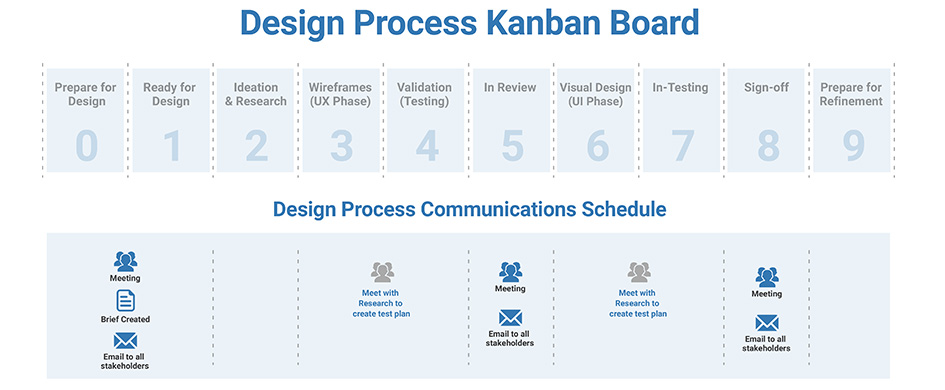The product design function in Ryanair is part of Digital Marketing - an extremely diverse department comprising product managers, business analysts, CRM managers, marketing executives and researchers as well as designers.
When designers join the Digital Marketing team, they are permanently assigned to a dedicated 'pod'. Each pod comprises a Product Owner, a Business Analyst, a UI Designer and a UX Designer.
While there are some positives to the 'pod' structure, one of the downside effects of is that each pod tended to work independently from the design department as a whole, and each pod worked and communicated in its own way.
For senior stakeholders, this practice caused a lot of frustration as delivery schedules, communication practices and software varied from pod to pod.
As Design Studio Manager, I was tasked with creating a new design process which could be followed by all pods, while still providing enough flexibility to allow teams to work at different paces or in a specialised way.
The solution I developed was based on several interviews with designers, product owners and stakeholders, and it broke the design process into 3 layers of granularity.


At the top level, we defined 4 phases that every design project should observe.
Discovery: At the start of the project, Product Owners and Analysts should work with business to understand the problem or task at hand. This is a divergent phase, where they explore the problem and consider multiple solutions
Define: Having explored a number of ways to solve a problem, Product Owners start to refine the project and prepare a brief which includes the required insights needed before handover to design. This is a convergent phase where the project narrows scope to focus on one particular area.
Design: At this point, the project moves from Product Owner to design in the form of a brief that has been agreed with stakeholders. Design team ideate on the idea within the scope outlined by Product Owners. This is a divergent phase. Designers should be exploring many possible options and considering different solutions.
Deliver: At the end of the design phase, there should be an agreement on the overall UX of the chosen design. This is a convergent phase as the design team focus on design iteration and validation. Towards the end of the phase, the design passes towards front end Ui design, before user testing and, ultimately sign-off.
Within each of the broad phases above, we defined a series of mini steps. There is a great deal of fluidity to these steps and projects are expected to move through the steps at different speeds, even - when necessary - move backwards.
The final layer of granularity is a 9 step Kanban workflow. Projects were tracked on a virtual Kanban board, which was tied to a communications schedule for each project.

At step 1 of the Kanban board, projects were marked 'Prepare for Design' until a project brief was emailed. At step 5 in the Kanban board, a team meeting was called and an email sent to stakeholders to advise them of the project readiness.
In all, this project helped bring a uniformity to the Ryanair Design Studio, and improved project workflow and communications, making it easier to take projects from kickoff through to Dev-ready refinement.